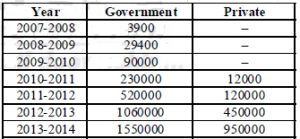Hello Aspirants. Welcome to Online Quant Section in AffairsCloud.com. We are starting IBPS Clerk course 2015 and we are creating sample questions in Quantitative Aptitude section, type of which will be asked in IBPS Clerk Prelims Exam.
Stratus – IBPS Clerk Course 2015

[flipclock]
Directions (1-5): Study the following table and answer the questions that follow:
- In which period the percentage increase in the total internet owners is least to that over the earlier period?
A) 2009-2010
B) 2010-2011
C) 2011-2012
D) 2013-2014
E) None of theseD) 2013-2014
Explanation:
In this first you will have to calculate total owners in each fiscal year, and then find the percentage increase for adjacent years.
Like for yr 2012-13, total owners are 15,10,000
For yr 2013-2014, total owners are 25,00,000.
So % increase = 25,00,000-15,10,000/ 15,10,000 * 100 = 65.56% - What is the total number of fresh internet owners in the period 2013-14?
A) 54900
B) 549000
C) 990000
D) 99000
E) None of theseC) 990000
Explanation:
For yr 2012-13, total owners are 15,10,000
For yr 2013-2014, total owners are 25,00,000.
So fresh owners are 25,00,000-15,10,000 = 99,0000 - What is the proportion of Government internet owners to the Private internet owners in the period 2011-12?
A) 13 : 4
B) 13 : 3
C) 3 : 13
D) 4 : 13
E) None of theseB) 13 : 3
Explanation:
520000 : 120000
13 : 3 - What is the approximate percentage increase in the Private internet owners in the period 2013-14 over that in the period 2010-11?
A) 5000
B) 6000
C) 8000
D) 4000
E) None of theseC) 8000
Explanation:
For yr 2010-11, private owners are 12,000
For yr 2013-2014, private owners are 9,50,000.
% increase = (9,50,000 -12,000) / 12,000 * 100 = 7816.67 ≈ 8000 - What is the approximate percentage of Private internet owners in the total internet owners in 2010-11?
A) 20
B) 5
C) 10
D) 15
E) None of theseB) 5
Explanation:
Total owners in 2010-11 = 12,000 + 2,30,000 = 2,42,000
So required % = 12000/242000 * 100 = 4.9 ≈ 5 - 18 men can do a piece of work in 26 days. 20 women can do the same piece of work in 33 days. 13 men start the work and do 1/3rd of the work. Now they are replaced by 22 women. In how many days the total work will be completed?
A) 32
B) 40
C) 4
D) 56
E) None of theseA) 32
Explanation:
18 m – 26 days, so 13 men do in 18*26/13 = 36 days. They complete 1/3rd of work. So number of days required by 13 men to complete that work is 36* 1/3= 12 days.
Now:
20 w – 33 days, so 22 w do in 20*33/22 = 30 days. They complete 2/3rd of work. So number of days required by 22 women to complete that work is 30* 2/3 = 20 days.
So total 12 +20 = 32 days - There is a profit of Rs 1200 on an article when 1/3rd of it is sold at 9% profit and remaining at 3% loss. Find the cost price of the aricle.
A) Rs 1,80,000
B) Rs 1,50,000
C) Rs 1,60,000
D) Rs 1,20,000
E) None of theseD) Rs 1,20,000
Explanation:
It can be calculated as:
CP = 1200 *100 / [1/3 *9 + 2/3 * (-3)] = 1,20,000
* 1/3rd sold at 9% profit, 2/3rd sold at 3% loss - There are 3 white balls, 4 yellow, and 5 green balls. 3 balls are drawn at random. What is the probability of all white or all green balls?
A) 9/150
B) 5/186
C) 11/220
D) 11/240
E) 13/220C) 11/220
Explanation:
Probability of all white = 3C3 / 12C3 = 1/220
Probability of all green = 5C3 / 12C3 = 10/220
So probability of all white or all green = 1/220 + 10/220 = 11/220 - The compound interest on a certain sum of money for 2 years at 20% per annum is Rs 3,520. Find the simple interest at the same rate and for the same time.
A) Rs 3000
B) Rs 3200
C) Rs 3635
D) Rs 3400
E) Rs 3440B) Rs 3200
Explanation:
If P is the principal, SI for 2 yrs = P*20*2/100 = 2P/5
So, SI for 1 yr = P/5
CI for 2 yrs = P/5 + (P/5 + 20/100 * P/5) = 2P/5 + P/25 = 11P/25
Now, 11P/25 = 3520, so P = 8,000
So SI = 2*8000/5 = 3200 - A person travels at a speed of 50 km/hr for 5 hours and at 60 km/hr for 3 hours. After this he could cover only 2/5th of the distance of his journey. At what speed should he travel now, so as to complete his remaining journey in 15 hours?
A) 40 km/hr
B) 45 km/hr
C) 42 km/hr
D) 43 km/hr
E) None of theseD) 43 km/hr
Explanation:
Distance travelled when 2/5th of journey is completed = 50*5 + 60*3 = 430 km.
This means 2/5 of total distance = 430. So total distance = 1075 km
Now he has to cover 3/5 * 1075 = 645 km in 5 hours.
So speed = 645/15 = 43 km/hr
AffairsCloud Recommends Oliveboard Mock Test
AffairsCloud Ebook - Support Us to Grow
Govt Jobs by Category
Bank Jobs Notification

